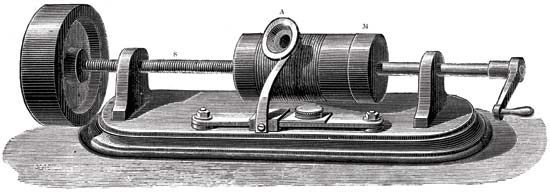
140 Years of the Phonograph!
This Saturday, August 12th marks the 140th anniversary of the invention of the phonograph, by Thomas Edison. We decided to pay tribute by sharing a little bit of history, a discussion on the cultural significant and some personal stories about our relationship with this world changing invention. Of course, there is so much more to the story than we could ever cover here. Our aim is to highlight the fact that records have been around for a long time and they’re not going anywhere, anytime soon. 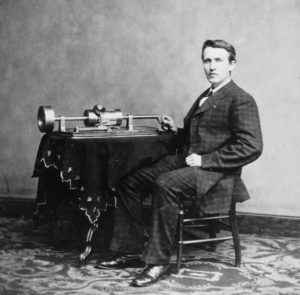
“Mr. Thomas A. Edison recently came into this office, placed a little machine on our desk, turned a crank, and the machine inquired as to our health, asked how we liked the phonograph, informed us that it was very well, and bid us a cordial good night.” – Scientific American Publication
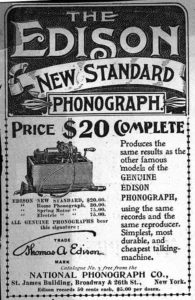 1877 to 1900s
1877 to 1900s
It is often said that necessity is the mother of invention. However, the phonograph was one of those rare inventions that preceded any needed application. It was seen by Edison and others to be a handy tool for correspondence, or perhaps a way to record telephone conversations. Recorded music wasn’t completely disregarded. But, it was considered more for music boxes or singing dolls, rather than any serious music listening. Also, the early wax and metal cylinders weren’t reliable and sounded terrible, by today’s standards. It wasn’t until more reliable material, better suited for capturing sounds were used that recorded music started to take hold. But even so, early Phonographs and Graphaphones were mostly owned by the upper class and used more as a parlor trick.
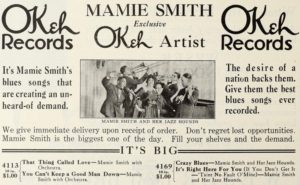 1900s to 1920s
1900s to 1920s
In the early 1900s, improved machines and easier reproduced shellac records started to find their way into more homes and at varying prices. This was no longer a medium for the upper class. The recordings began to reflect this, as well, featuring more blues, folk, jazz and country artists, introducing new music to people of varying ethnic, social and economic backgrounds. Soldiers traveling oversees would bring a piece of home with them, in the form of their favorite records, introducing American music to an even further removed audience. Like the telegraph and telephone, records were making the world a bit smaller.
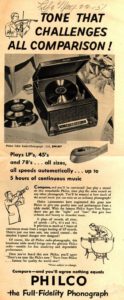 1920s to 1950s
1920s to 1950s
Much like the internet’s effect on tangible music, improvements in radio broadcasting seemed to be the death of records and record players. But, like the internet, as much as radio served to be a primary source for listening to music, it also served to introduce more people to songs and artists they hadn’t heard before. This, along with many improvements in audio fidelity created a boom for the record industry. Shortly after this time, improvements were being made with new electronic speakers and improved styluses, furthering the demand for recorded music. Records had arrived and were now the chosen source for your favorite songs and artists. By this time, music had transformed, as well, to better fit this new format. Composers were writing long pieces with movements timed to fit on one side of a record; Jazz, country, blues and folk songs all adopted a 3 to 4 minute format because of the time limitation of records. This is a format that rock and pop music follows, to this day.
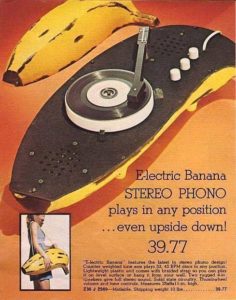 1950s to Present Day
1950s to Present Day
This is where we write our own stories. Not much has changed with records or record players over the past 60 years. But, records continue to be a huge part of our lives. Other technologies have come and gone. But, Vinyl records have shown their resilience in the face of dubious claims that something better has come along and will inevitably replace this time tested media. It’s hard to pin down exactly what it is about vinyl records that has kept our attention for so long. Perhaps it’s the simplicity involved in creating these tangible manifestations of music. Perhaps the simple elements of sound vibration and friction carving it’s way through material to build something larger than the sum of it’s parts represents the ingenuity and creative spirit of the human race. Maybe it’s the fact that we can connect generations through this simple form of entertainment. We keep records of who our parents and grandparents and great grandparents are and were through these small discs. They are mementos that are to be cared for and displayed, as much as they are to be held and used. What else in our lives serves so many purposes? Name another thing in your life that identifies you as a person, acts as a centerpiece to your living space, is used on a daily basis and will be used for most of your life, and in the end, will go and create new stories for others, be it your own family or complete strangers.
We all have stories about vinyl. We hear these stories at the shop. Whether you’ve been buying records since you were a kid, just now getting into them or gave up at some point, only to realize how much you miss the experience, chances are, you have a story that puts vinyl records at the center of some pivotal moments in your life. Please share some of those stories with us. We would also love to see photos of your record players, shared in the comments below.